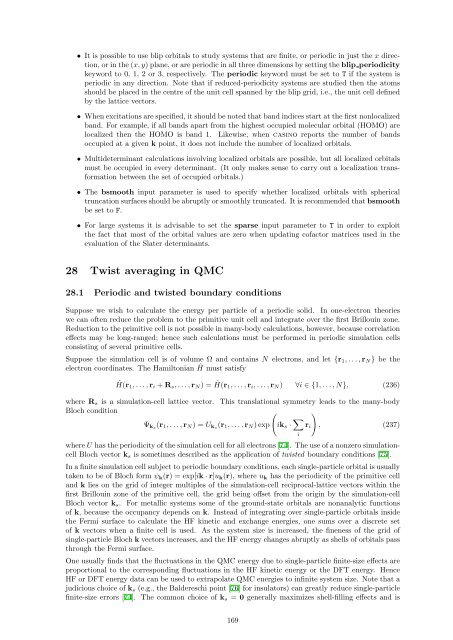CASINO manual - Theory of Condensed Matter
CASINO manual - Theory of Condensed Matter
CASINO manual - Theory of Condensed Matter
Create successful ePaper yourself
Turn your PDF publications into a flip-book with our unique Google optimized e-Paper software.
• It is possible to use blip orbitals to study systems that are finite, or periodic in just the x direction,<br />
or in the (x, y) plane, or are periodic in all three dimensions by setting the blip periodicity<br />
keyword to 0, 1, 2 or 3, respectively. The periodic keyword must be set to T if the system is<br />
periodic in any direction. Note that if reduced-periodicity systems are studied then the atoms<br />
should be placed in the centre <strong>of</strong> the unit cell spanned by the blip grid, i.e., the unit cell defined<br />
by the lattice vectors.<br />
• When excitations are specified, it should be noted that band indices start at the first nonlocalized<br />
band. For example, if all bands apart from the highest occupied molecular orbital (HOMO) are<br />
localized then the HOMO is band 1. Likewise, when casino reports the number <strong>of</strong> bands<br />
occupied at a given k point, it does not include the number <strong>of</strong> localized orbitals.<br />
• Multideterminant calculations involving localized orbitals are possible, but all localized orbitals<br />
must be occupied in every determinant. (It only makes sense to carry out a localization transformation<br />
between the set <strong>of</strong> occupied orbitals.)<br />
• The bsmooth input parameter is used to specify whether localized orbitals with spherical<br />
truncation surfaces should be abruptly or smoothly truncated. It is recommended that bsmooth<br />
be set to F.<br />
• For large systems it is advisable to set the sparse input parameter to T in order to exploit<br />
the fact that most <strong>of</strong> the orbital values are zero when updating c<strong>of</strong>actor matrices used in the<br />
evaluation <strong>of</strong> the Slater determinants.<br />
28 Twist averaging in QMC<br />
28.1 Periodic and twisted boundary conditions<br />
Suppose we wish to calculate the energy per particle <strong>of</strong> a periodic solid. In one-electron theories<br />
we can <strong>of</strong>ten reduce the problem to the primitive unit cell and integrate over the first Brillouin zone.<br />
Reduction to the primitive cell is not possible in many-body calculations, however, because correlation<br />
effects may be long-ranged; hence such calculations must be performed in periodic simulation cells<br />
consisting <strong>of</strong> several primitive cells.<br />
Suppose the simulation cell is <strong>of</strong> volume Ω and contains N electrons, and let {r 1 , . . . , r N } be the<br />
electron coordinates. The Hamiltonian Ĥ must satisfy<br />
Ĥ(r 1 , . . . , r i + R s , . . . , r N ) = Ĥ(r 1, . . . , r i , . . . , r N ) ∀i ∈ {1, . . . , N}, (236)<br />
where R s is a simulation-cell lattice vector. This translational symmetry leads to the many-body<br />
Bloch condition<br />
(<br />
Ψ ks (r 1 , . . . , r N ) = U ks (r 1 , . . . , r N ) exp ik s · ∑ )<br />
r i , (237)<br />
where U has the periodicity <strong>of</strong> the simulation cell for all electrons [74]. The use <strong>of</strong> a nonzero simulationcell<br />
Bloch vector k s is sometimes described as the application <strong>of</strong> twisted boundary conditions [75].<br />
In a finite simulation cell subject to periodic boundary conditions, each single-particle orbital is usually<br />
taken to be <strong>of</strong> Bloch form ψ k (r) = exp[ik · r]u k (r), where u k has the periodicity <strong>of</strong> the primitive cell<br />
and k lies on the grid <strong>of</strong> integer multiples <strong>of</strong> the simulation-cell reciprocal-lattice vectors within the<br />
first Brillouin zone <strong>of</strong> the primitive cell, the grid being <strong>of</strong>fset from the origin by the simulation-cell<br />
Bloch vector k s . For metallic systems some <strong>of</strong> the ground-state orbitals are nonanalytic functions<br />
<strong>of</strong> k, because the occupancy depends on k. Instead <strong>of</strong> integrating over single-particle orbitals inside<br />
the Fermi surface to calculate the HF kinetic and exchange energies, one sums over a discrete set<br />
<strong>of</strong> k vectors when a finite cell is used. As the system size is increased, the fineness <strong>of</strong> the grid <strong>of</strong><br />
single-particle Bloch k vectors increases, and the HF energy changes abruptly as shells <strong>of</strong> orbitals pass<br />
through the Fermi surface.<br />
One usually finds that the fluctuations in the QMC energy due to single-particle finite-size effects are<br />
proportional to the corresponding fluctuations in the HF kinetic energy or the DFT energy. Hence<br />
HF or DFT energy data can be used to extrapolate QMC energies to infinite system size. Note that a<br />
judicious choice <strong>of</strong> k s (e.g., the Baldereschi point [76] for insulators) can greatly reduce single-particle<br />
finite-size errors [74]. The common choice <strong>of</strong> k s = 0 generally maximizes shell-filling effects and is<br />
i<br />
169

















